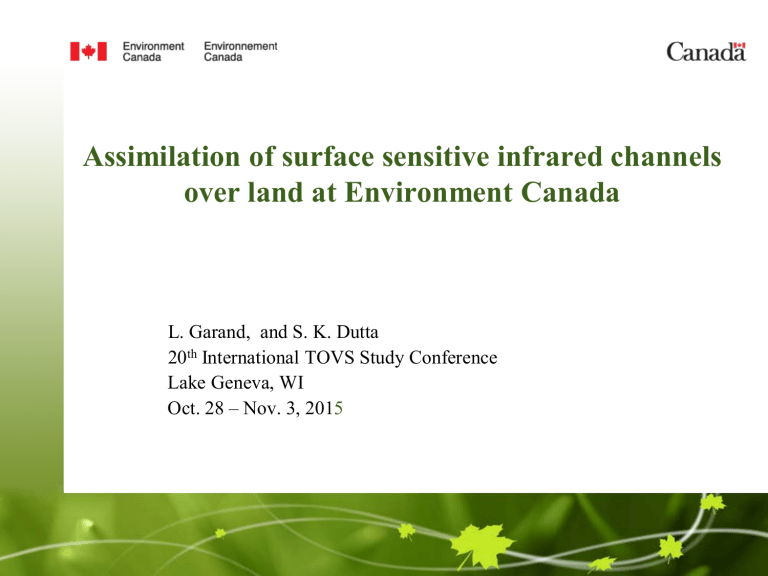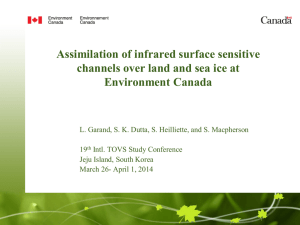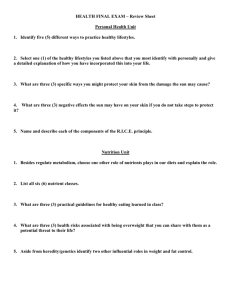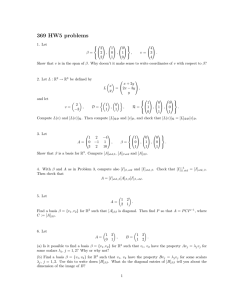Assimilation of surface sensitive infrared channels over land at Environment Canada 20

Assimilation of surface sensitive infrared channels over land at Environment Canada
L. Garand, and S. K. Dutta
20 th International TOVS Study Conference
Lake Geneva, WI
Oct. 28 – Nov. 3, 201 5
Motivation
• Hyperspectral IR under-used over land and sea ice, i.e. not used if surface sensitive.
• Recent NWP context at EC is favorable:
- Flow-dependent background errors including surface skin temperature correlations with other variables
Analysis grid at 50 km, model at 25 km
142 AIRS and IASI (METOP-A) channels assimilated: many sensitive to low level T, q, and T s
Impact potential to explore over land
2
Challenges
• Adding valuable information of existing in-situ data
sources such as surface and aircraft data
• Need a reliable cloud mask
• Reliable spectrally resolved surface emissivity
• Representativeness (e.g. variable topography)
• Relatively poor background field of T s over land
• Radiance bias correction issue
3
Approach
• EnVar with background errors from ENKF system,
192 members
• Added data evaluated are from AIRS and IASI over land
• Bias correction for surface sensitive channels based on oceanic data only
• Thinning of radiances is at 150 km
• T s
is part of model state, but T s
analysis increments are ignored
• Radiative transfer model: RTTOV-11
• Emissivity: U-Wisconsin atlas, fixed per month
4
Limiting criteria for assimilation
Assimilate under these restrictive conditions, following several sensitivity tests:
• Estimate of cloud fraction < 0.01
• Exclude latitudes 60-90 N/S and sea ice
• High surface emissivity (> 0.90)
• Relatively flat terrain (local height STD < 50 m)
• Diff between background T s
and rough retrieval
based on inverting RTE limited to 4K
5
Limitation linked to topography
Criterion used: local STD of topography < 50 m (on 3X3 ~50 km areas)
White: accepted, red std > 100 m, blue 100 m >std> 50 m
6
Limitation linked to surface emissivity
Emissivity over desert area
Error of estimate
(from U-Wisconsin)
Accept only emissivity > 0.90 to limit uncertainty
7
Ensemble spread of T s
(Feb-Mar 2011
)
00 UTC 06 UTC
12 UTC 18 UTC
Maximum ~15h local
In SH (summer)
Maximum at night
Tibetan area (winter)
Ts background error over land in 4Dvar is
Constant: 3 K.
In EnVar, B is
0.5(B
ENKF
+ B
NMC
)
8
Std model vs retrieved T
s
~ 1K over ocean ; ~2.5-5.5 K over land and sea ice
Error estimate from retrievals comparable to ensemble spread
9
12 UTC
00 UTC
Error correlation between T skin
and T air
E[(T s
– T s-avg
) (T – T air-avg
)] 1/2 avg of 192 members, 2-month period
T air
at ~941hPa
Error correlation between
T skin
and T air
at low levels is typically positive in daytime but often negative at night.
It is zero over ocean since
SST is not perturbed.
10
Mean (O-B) AIRS-787, assimilated
~0 over ocean; ~0.5-1.5 K over land
(O-B) distribution over land skewed on warm side
11
STD (O-B) AIRS 787, assimilated
~ 0.5 K over ocean ; ~ 1.0-1.5 K over land
12
Results
2-month assimilation Feb 1- March 31 2011
CNTL: Equivalent to newly implemented Envar
EXP: same + surface-sensitive AIRS and IASI
(Metop A) over land under specified conditions
13
Mean T difference Exp-Control
Surface ~941hPa
Analysis
=
Trial
+
Increment
Cooler analysis at low levels on average
Mean positive
Increments near the surface only
14
NH-
Extra-
Trop
SH-
Extra-
Trop
T STD difference vs lead time
red / blue means pos / neg impact of experiment
vs ERA Interim vs own analysis
15
Time series of T bias, T std at 850 hPa vs ERA-Interim, at 24-h, 72-h, 120-h, NH-extro
BIAS STD EXP CNTL
Bias improved at all times, std improved at 72-h and beyond
16
Temperature anomaly correlation
NH-Extratropics
EXP / CNTL
925 hPa 850 hPa
Significant impact at days 3-4
17
Validation vs radiosondes 120-h
EXP CNTL
North America NH-extratropics
U V U V
GZ T GZ T
18
Added yield: about 17%
(for surface sensitive channels)
Number of radiances assimilated for surface channel AIRS 787
CNTL : ~1290/6h EXP : ~1550/6h
CNTL
EXP
Region: world, EXP excludes surface-sensitive channels at latitudes > 60 N/S
Radiance thinning is at 150 km
19
Std/bias of (O-B) and (O-A), AIRS 787
CNTL (ocean only) EXP (ocean + land)
6-h cycle; Feb. 1 to March 31
O-B
O-A
No major impact on analysis bias. Over land std (O-P) is ~1.7 K,
Bias is ~1.2K, and std (O-A) is ~0.4 K.
20
Conclusion
• Encouraging results, significant positive impact in NH
• Impacts up to day 5 significant
• Consistent results vs analysis and radiosondes
• Negative impact early in forecast in NH requires investigation
Way forward:
• Ongoing summer cycle including Cris and IASI (Metop B)
• Assimilate retrieved Ts in land surface analysis to add consistency with atmospheric analysis
• Seek consistency in emissivity definition in assimilation and in the model (broadband)
• Validate/improve cloud detection
This work to appear in JAMC, Dutta et al., 2016
21




